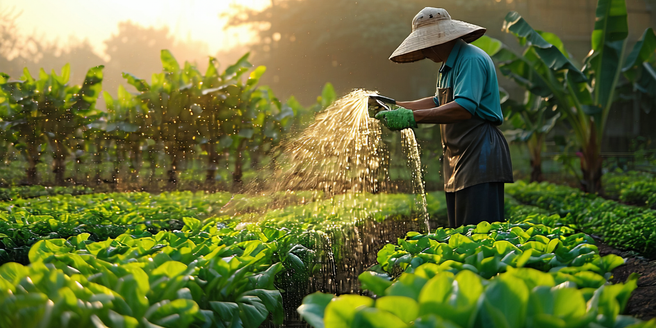
Understanding Heatwave Impacts on Plants
Heatwaves can dramatically affect plant health as they lose water rapidly through transpiration. High temperatures can cause stress, leading to wilting. During heatwaves, plants often experience nutrient deficiencies because the soil’s biology is disrupted. Roots may struggle to draw in water, reducing photosynthesis efficiency. Heat-sensitive plants, including many vegetables and flowering species, are particularly vulnerable. Gardeners may notice leaf curling or scorching as the leaves try to reduce sunlight exposure. Recognizing these impacts early helps in mitigating long-term damage. Providing shade and maintaining optimal soil moisture are critical steps to safeguarding plant health during such climatic extremes.
Efficient Watering Techniques for Hot Weather
Proper watering techniques become crucial during heatwaves. Watering during early morning or evening minimizes evaporation, ensuring more moisture reaches the roots. Drip irrigation systems offer an efficient solution by delivering water directly to the root zone. Deep watering encourages roots to grow deeper, enhancing resilience against heat stress. Mulching around plants helps retain soil moisture and reduces surface temperature. Avoiding overhead watering can prevent leaf scorch by minimizing water droplets acting as magnifying glasses under intense sun. Adjusting watering schedules according to specific plant needs and local climate variations can mitigate drought stress during hot weather.
Choosing Heat-Resistant Plants for Your Garden
Selecting heat-resistant plants is key to sustaining a vibrant garden in warm climates. Native species are generally well adapted to local conditions. Succulents, such as sedums and agaves, are excellent choices due to their water-storing capabilities. It’s also helpful to group plants with similar water needs together to optimize garden care. Mediterranean herbs like rosemary and lavender thrive in summer heat. Ornamental grasses and perennials like daylilies are also known for their resilience. During selection, consider plants with silver or gray foliage which reflects sunlight, reducing heat absorption. Drought-tolerant plants require less water, making them both environmentally and economically beneficial during extended periods of high temperatures.
Mulching: A Barrier Against Heat Stress
Mulching acts as an effective barrier against heat stress by keeping soil temperatures down and moisture in. Organic mulches, such as straw or bark, decompose and enrich soil while providing insulation. They prevent sunlight from directly hitting the soil surface, reducing the soil’s thermal load. Applying a thick layer of mulch helps suppress weed growth, which competes for resources with garden plants. Mulch ensures that necessary soil microorganisms stay active, supporting plant health through nutrient recycling. Choosing the right mulch can aid in soil temperature regulation and water conservation, two critical factors during heatwaves.
Creative Shading Solutions to Protect Plants
Shading strategies are essential to safeguard plants from excessive sun exposure. Utilizing shade cloth can offer varied levels of protection depending on the percentage of sunlight blocked. Adjustable shade sails or garden umbrellas provide flexibility in controlling light access as needed. In particular, choosing products with UV protection can extend their lifespan and efficiency. Planting taller foliage or using trellises with climbing plants can naturally create cooler microenvironments. Additionally, reflective materials, like aluminum foil, can deflect sunlight away from sensitive areas. Creative shading not only mitigates heat stress but often enhances the garden’s aesthetic appeal, ensuring both function and beauty are maintained during hot spells.
Monitoring and Adjusting Soil Conditions in Heat
Regularly monitoring soil conditions is vital during heatwaves. Measuring soil moisture levels prevents over or under-watering, helping maintain optimal growing conditions. To ensure the best results, consider setting up a regular schedule for checking these levels. Soil sensors can provide real-time data, allowing precise adjustments. Incorporating organic matter increases the soil’s water-holding capacity, maintaining plant health during dry periods. Testing for nutrient deficiencies is also essential, as heat can exacerbate imbalances. Ensuring proper drainage prevents root rot during unexpected rainfall. Adjusting the soil pH, if needed, can aid nutrient uptake. Understanding and responding to soil conditions enable proactive plant care, reducing stress during high temperatures.
